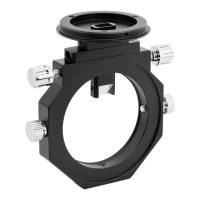2 3
Parts List (Figure 1)
1. Thin Off-Axis Guider main body
2. 2" Nosepiece
3. Canon camera-compatible ring adapter (bayonet)
4. Camera T-thread ring adapter
5. Step-down ring (M48 male to T-threads female)
6. Coma corrector spacer
7. C-mount to T-threads (Male-Female) adapter
8. Spacer (18mm long)
9. Hex key (not shown)
Congratulations on your purchase of the Orion Thin Off-Axis Guider (Orion
TOAG). This useful imaging accessory enables you to image and guide through
the same telescope, thereby eliminating the need for a separate guide scope,
which reduces payload weight on your mount and helps eliminate guiding error
due to flexure. All telescopes are prone to some degree of flexure, but an Off-
Axis Guider detects the exact same movement as the main camera so you are
assured high-accuracy guiding.
The Orion Thin Off-Axis Guider (TOAG) is especially useful where space (back-
focus) is critical, such as with Newtonian telescopes where back-focus is limited,
and for Schmidt-Cassegrain telescopes, which can experience “mirror flop”.
Things You Should Know Before Using the Orion TOAG
What a Thin Off-Axis Guider (TOAG) Is Used For:
A TOAG is a device used for astrophotography. It uses a small pick-off prism that
redirects a tiny portion of the incoming light from the telescope to an auxiliary
guide camera (autoguider).
Thin Off-Axis Guiders and DSLR Cameras:
Modern imaging cameras include dedicated astronomy CCD cameras and DSLR
cameras that provide an easy and affordable method of image acquisition.
One of the drawbacks of using a DSLR camera is the long back-focus (around
±44 mm depending on model). This limits its application on some telescopes,
especially where back-focus is limited, such as Newtonian telescopes with or
without coma correctors.
Some Newtonian telescopes, such as fast Newtonian astrographs (below f/4.5)
require the use of coma correctors in order to obtain pinpoint stars across the
focal plane. Coma correctors are usually optimized for a specific distance to the
imaging chip; about 54-56mm long depending on the camera maker and the
telescope focal ratio and corresponds to the back-focus of the camera plus the
thickness of a DSLR T-threads adapter, or T-ring.
DSLR T-rings are usually 10 mm thick. Our TOAG is about 10.5 mm thick to
insure compatibility with coma correctors.
Thin Off-Axis Guider and Newtonian Telescopes
Newtonian telescopes offer the best combination of aperture and cost; they can
also be very fast (low f/ratio) making them especially interesting for astrophotog-
raphy as they provide a wide field of view (FOV) and allow short exposure times.
Newtonians are also constructed in such a way that back-focus is, by design,
very limited. Guiding with a standard off-axis guider is usually not possible, mak-
ing the TOAG an essential accessory item when attempting to use a Newtonian
for deep sky imaging (since it adds very little back focus - around 10.5 mm).
1. Getting Started With a DSLR
Please take a moment to familiarize yourself with the parts (Figure 1).
The Orion TOAG comes with a 2" nosepiece (#2) with a T-female to C-mount
adapter already attached (#7). Two camera ring adapters (#3 and #4) are sup-
plied in a separate plastic bag. You should remove the C-mount to T-threads
adapter (#7) from the main body as you may require it to guide with your particu-
lar autoguider.
The TOAG accommodates nearly any autoguider camera, but special attention
should be taken with the autoguider weight since the TOAG has a very nar-
Figure 1. Parts included with the TOAG
WARNING: Never look directly at the Sun with the naked eye or with
a telescope – unless you have a proper solar filter installed over the
front of the telescope! Otherwise, permanent, irreversible eye damage
may result.

